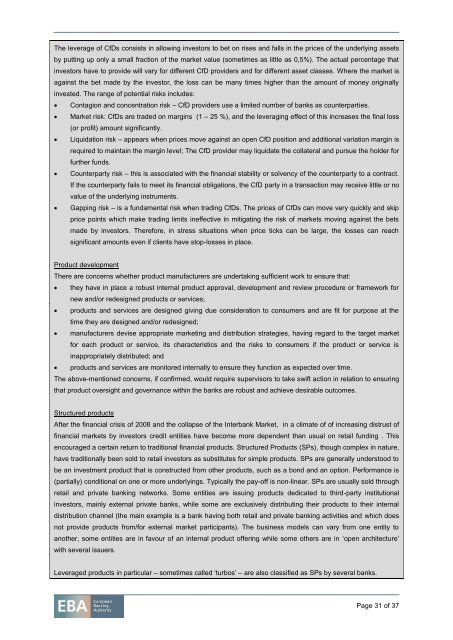EBA Long Report - European Banking Authority - Europa
EBA Long Report - European Banking Authority - Europa
EBA Long Report - European Banking Authority - Europa
You also want an ePaper? Increase the reach of your titles
YUMPU automatically turns print PDFs into web optimized ePapers that Google loves.
The leverage of CfDs consists in allowing investors to bet on rises and falls in the prices of the underlying assets<br />
by putting up only a small fraction of the market value (sometimes as little as 0,5%). The actual percentage that<br />
investors have to provide will vary for different CfD providers and for different asset classes. Where the market is<br />
against the bet made by the investor, the loss can be many times higher than the amount of money originally<br />
invested. The range of potential risks includes:<br />
Contagion and concentration risk – CfD providers use a limited number of banks as counterparties.<br />
Market risk: CfDs are traded on margins (1 – 25 %), and the leveraging effect of this increases the final loss<br />
(or profit) amount significantly.<br />
Liquidation risk – appears when prices move against an open CfD position and additional variation margin is<br />
required to maintain the margin level; The CfD provider may liquidate the collateral and pursue the holder for<br />
further funds.<br />
Counterparty risk – this is associated with the financial stability or solvency of the counterparty to a contract.<br />
If the counterparty fails to meet its financial obligations, the CfD party in a transaction may receive little or no<br />
value of the underlying instruments.<br />
Gapping risk – is a fundamental risk when trading CfDs. The prices of CfDs can move very quickly and skip<br />
price points which make trading limits ineffective in mitigating the risk of markets moving against the bets<br />
made by investors. Therefore, in stress situations when price ticks can be large, the losses can reach<br />
significant amounts even if clients have stop-losses in place.<br />
Product development<br />
There are concerns whether product manufacturers are undertaking sufficient work to ensure that:<br />
they have in place a robust internal product approval, development and review procedure or framework for<br />
new and/or redesigned products or services;<br />
products and services are designed giving due consideration to consumers and are fit for purpose at the<br />
time they are designed and/or redesigned;<br />
manufacturers devise appropriate marketing and distribution strategies, having regard to the target market<br />
for each product or service, its characteristics and the risks to consumers if the product or service is<br />
inappropriately distributed; and<br />
products and services are monitored internally to ensure they function as expected over time.<br />
The above-mentioned concerns, if confirmed, would require supervisors to take swift action in relation to ensuring<br />
that product oversight and governance within the banks are robust and achieve desirable outcomes.<br />
Structured products<br />
After the financial crisis of 2008 and the collapse of the Interbank Market, in a climate of of increasing distrust of<br />
financial markets by investors credit entities have become more dependent than usual on retail funding . This<br />
encouraged a certain return to traditional financial products. Structured Products (SPs), though complex in nature,<br />
have traditionally been sold to retail investors as substitutes for simple products. SPs are generally understood to<br />
be an investment product that is constructed from other products, such as a bond and an option. Performance is<br />
(partially) conditional on one or more underlyings. Typically the pay-off is non-linear. SPs are usually sold through<br />
retail and private banking networks. Some entities are issuing products dedicated to third-party institutional<br />
investors, mainly external private banks, while some are exclusively distributing their products to their internal<br />
distribution channel (the main example is a bank having both retail and private banking activities and which does<br />
not provide products from/for external market participants). The business models can vary from one entity to<br />
another, some entities are in favour of an internal product offering while some others are in ‘open architecture’<br />
with several issuers.<br />
Leveraged products in particular – sometimes called ‘turbos’ – are also classified as SPs by several banks.<br />
Page 31 of 37
















